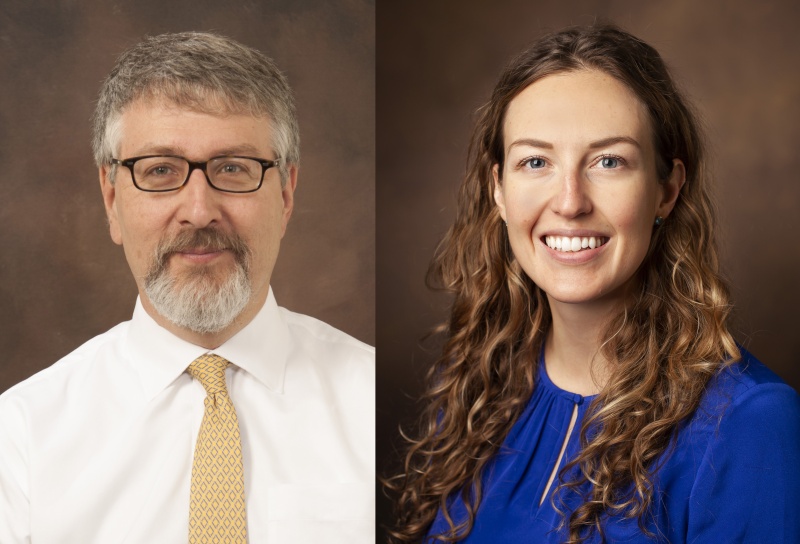Featured in the Winter 2023 edition of Vanderbilt Radiology Society's alumni newsletter, The Reader.

When Mary Ellen Koran, MD, PhD, Assistant Professor of Radiology and Radiological Sciences, was a student in Vanderbilt University’s Medical Scientist Training Program pursuing her MD/PhD, she didn’t think she was going to enter a residency program.
Originally, she only wanted her medical degree so that she wouldn’t be denied access to resources or patients—an issue she witnessed her PhD mentors endure while she was performing her own undergraduate research. Dr. Koran completed her first two years of medical school and still believed in her pathway: she would receive her PhD in genetics and skip residency to focus exclusively on research.
Then, at the end of her second year (2011), a doctor came to speak with students about neuroradiology. What may have seemed like a standard lecture actually changed the trajectory of Dr. Koran’s life.
“I saw the possibility of being able to diagnose a patient without having to cut someone open—or do a history and physical,” Dr. Koran says with a laugh.
The presenter was VUMC Radiology’s own Jeffrey Creasy, MD, Professor of Radiology and Radiological Sciences, who first joined the team in 1988. As Dr. Creasy explains, the talk was given at an award-winning neuroscience class, led by course director Jeanette Norden, PhD.
Dr. Creasy delivered several lectures on neuroradiology to students in the course. He described the diagnostic and therapeutic options available, including plain film, US, nuclear medicine, MR, CT, myelography, and angiography for diagnosis; and gave some examples of the emerging field of therapeutics that might best be called “interventional neuroradiology.” He presented examples of different categories of diseases that affected the brain, head and neck, and spine - such as trauma, infection, congenital, and tumors.
In one of those talks, Dr. Creasy included some images he’d acquired that demonstrated the technique of endovascular coiling of aneurysms (which was somewhat new at the time) as an alternative to performing an open craniotomy and open aneurysm clipping.
About a week after hearing Dr. Creasy speak about endovascular therapy, Dr. Koran had a serendipitous moment. She opened a newsletter from the Human Genetics department. It explained that the department had just hired a new faculty member who was looking for students in her Imaging-Genetics lab—using quantitative traits from images (like how much the brain shrinks over time) in genetics studies.
“It was there that my love of imaging really grew,” Dr. Koran says. “I realized I wanted to be a radiologist-scientist so I could combine my love of research with my newfound love for imaging.”
It was Reed Omary, MD, MS, Carol D. and Henry P. Chair and Professor of the Department of Radiology and Radiological Sciences, who further connected the dots. He later introduced Dr. Koran to Daniel Brown, MD, FSIR, Vice Chair of Innovation & Clinical Research and Professor for the department. Through the clinical mentorship she received from Dr. Brown, Dr. Koran’s career path was redefined.
Next, she matched at Stanford Medicine, where she pursued a dual-board Diagnostic Radiology and Nuclear Medicine pathway. Dr. Koran was then recruited back to Vanderbilt on the Physician-Investigator Tenure track, to help build the neuro-PET program for our Alzheimer’s Center and the Vanderbilt University Institute of Imaging Science.
On her first day back at Vanderbilt, Dr. Koran paid Dr. Omary a visit. In his office, she bumped into someone she’d met before: Dr. Creasy! It was truly a full-circle moment.
“I’m so thankful that he took the time to come lecture medical students about radiology!” Dr. Koran proclaims.
“It wasn't until several years later that I learned my lecture had been part of the reason why Dr. Koran had made a decision to enter the field of radiology,” Dr. Creasy explains. “As both a clinician and more specifically an educator, it is rewarding to know that time spent teaching does have an impact on students. Now, it is it wonderful to have Dr. Koran as a faculty member here at Vanderbilt. I know that she will have a very successful career within academic radiology.”
Moving forward, Dr. Koran has inspiring long-term career goals. She is currently member of the Vanderbilt Memory & Alzheimer's Center. She hopes to one day lead an independent NIH-funded program focused on creating and validating novel, clinically translatable applications of existing and emerging positron emission tomography (PET) tools to better diagnose and monitor diseases adversely affecting the brain—and to integrate those tools into genetics studies.